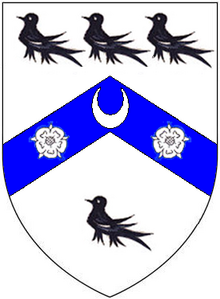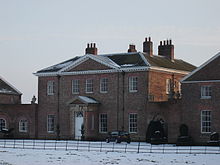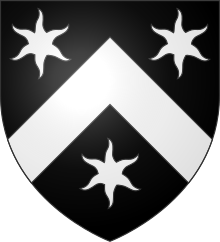Houghton Hall (Yorkshire)
Houghton Hall is in the Georgian style built villa in Sancton in Market Weighton in the English Management Unit East Riding of Yorkshire . English Heritage has listed it as a Grade I Historic Building. The property has an area of 23 km². On the property is the village of Sancton and the remains of the old hamlet of Houghton . Philip Langdale (died 1815) had the country house built between 1765 and 1768 according to the plans of the builder Thomas Atkinson . The architect Francis Johnson changed it slightly in 1960. The house is made of pink bricks with stone cladding and has a slate roof. The two-story main building has a five-part front facade.
The Roman Catholic parish of Market Weighton started out from the Langdale family's house chapel at Houghton Hall. This chapel was built in 1829 and demolished in 1957. The Vale of York polo club was previously located on the Houghton Hall estate.
History of the owner
Langdale
The Langdales had lived in the area west of Beverley since the 14th century at the latest, when Patrick de Langdale and Elena Houghton married and inherited the properties in Houghton and Etton.
The Houghton estate was inherited from Nathony Langdale through the older line of the Langdale family, until the lack of direct male heirs led to an inheritance on a side branch to cousin Peter Langdale (d. 1617) and his son Marmaduke (born 1598). Marmaduke was knighted by King Charles I in 1628 , held the office of Sheriff of Yorkshire from 1639 to 1640 and was an avid royalist in the English Civil War , in which he took part in the battles of Marston Moor and Naseby . After the defeat of the Royalists, he fled to mainland Europe and joined the later King Charles II , who made Langdale 1st Baron in 1658. He later converted to Catholicism. The title expired with the death of Marmaduke Langdale, 5th Baron Langdale , in 1778, who left no son but only two daughters. The country house and 3.96 km² of land fell to Philip Langdale (d. 1815), the oldest male descendant of the Langdale family, who had today's country house built around 1765. The family continued to live as Catholic rebels and a year after the country house was completed, a position for a Catholic priest was established there.
Stourton (Langdale)

After the death of Philip Langdale in 1815, the property fell to his relatives, the Hon. Charles Langdale (1787–1868, nee Charles Stourton), member of Parliament and supporter of Catholic emancipation , who with royal permission under the Langdales family name and coat of arms accepted the legacy. He was the fourth son of Charles Stourton, 17th Baron Stourton , and married to Mary Langdale, a daughter and co-heir of Marmaduke Langdale, 5th Baron Langdale. He expanded the property and the country house, to which he had a Roman Catholic chapel built in the classicist style in 1829 according to plans by Joseph Ireland . He was a Member of Parliament for the Beverley and Knaresborough constituencies. Philip died in 1868 and his eldest son, Charles Joseph Langdale (1822–1895), succeeded him. He married an Irish heiress and then lived in Ireland. After the couple's death in 1895, their eldest son, Henry Joseph Langdale (1853-1923), and then their younger son, Lieutenant-Colonel Philip Joseph Langdale (1863-1950), inherited the property.
After Philip's death in 1950, Houghton Hall fell to his eldest daughter, Joyce Elizabeth Mary Langdale (1898 – June 1995), then the wife of Henry FitzAlan-Howard, 2nd Viscount FitzAlan of Derwent (1883–1962), from whom she was divorced in 1955 . She then married in 1956 William Thomas George Wentworth-FitzWilliam, 10th Earl FitzWilliam (1904–1979). Her second husband's home, Wentworth Woodhouse near Rotherham , is the largest private residence in England. She also had the largest house in Cambridgeshire , Milton Hall in Peterborough, as a second residence . So she had no need to use Houghton Hall as an apartment as well.
Watson

Joyce Langdale had no male offspring and gave Houghton Hall to her nephew, Rupert Watson, 3rd Baron Manton (1924-2003), the only son of her younger sister Alethea Alys Mary Pauline Langdale , wife of George Miles Watson, 2nd Baron Manton (1899–1968) who lived at Compton Verney House in Warwickshire and later in Plumpton Place in Sussex . Rupert had five children and later was the senior steward of the jockey club. He succeeded his father in 1968 as 3rd Baron Manton and in 1980 was appointed Deputy Lieutenant of Humberside. After his death in 2003, the title and estate passed to his eldest son, Miles Ronald Marcus Manton, 4th Baron Manton (born 1958), a Life Guards officer and formerly successful amateur jockey.
Individual evidence
- ^ Houghton Hall, List Entry No. 1160656 . Historic England. Retrieved April 7, 2015.
- ↑ Houghton Hall, Sancton . British Listed Buildings. Retrieved April 7, 2015.
- ^ Thomas Robson: The British Herald .
- ^ University Archives . University of Hull. Retrieved April 7, 2015.
- ↑ Debrett's Peerage . 1968. p. 807: Baron Mowbray .
- ↑ Debrett's Peerage . 1968. p. 739: Baron Manton .
- ↑ Debrett's Peerage . 1968. pp. 452, 453.
Web links
Coordinates: 53 ° 50 ′ 27.6 ″ N , 0 ° 39 ′ 5 ″ W.


